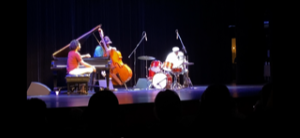Most references estimate that over 270 operas have been composed using librettos based on the plays of William Shakespeare. Most lie on archive shelves. Verdi’s masterful Otello and Falstaff are part of the international repertory. Hovering at the edge, outside of France, is the Roméo et Juliette of Charles Gounod. His librettists, Jules Barbier and Michel Carré, followed the Bard pretty closely by operatic standards. It has the balcony scene, Mercutio’s Queen Mab setting, and the lovers at dawn. This being an opera, the lovers must also have a final duet. Indeed, there are no less than four love-duets throughout!
My enthusiasm for Gounod’s Roméo et Juliette was fanned by a fine traditional production by the Virginia Opera Company I reviewed in November 2005. Anticipation was keen for Spoleto’s production since instrumental and vocal standards are high and festival General Director Nigel Redden has a taste for “cutting edge” and updated approaches. We heard the performance June 3 in Gaillard Municipal Auditorium. The Festival Orchestra played with fire for conductor Tommaso Placido, who led a stylish performance notable for a refined color palette and finely judged dynamics. Co-ordination between the stage and the pit were excellent.
Both the chemistry between the title characters and their vocal quality are essential to this opera. Here the Spoleto production succeeded completely. Both artists are young and physically attractive, so important to modern audiences. Best of all, they were superb singers with agile voices, solidly supported, and dead-center intonation. It was easy to see why the Juliette, soprano Nicole Cabell, had won the BBC Cardiff Singer of the World competition in 2005. Her fast notes were precise and her timbre was warm and pleasing. Her application of vocal color was refined. Montréal-born tenor Frédéric Antoun possesses the ideal sound for French opera. He has a marvelous head tone and can spin a smooth and even musical line across his range. Both singers are consummate actors who fully conveyed their characters.
The supporting cast was strong, with robust voices and clear diction. The hot-headed Tybalt was tenor Ryan Robertson. Mezzo-soprano Christine Abraham’s swaggering body language made for a convincing Stephano, a “pants role.” Baritone Kevin Greenlaw’s turn as Mercuio rivaled the high standards set by Caball and Antoun. Given this production, Rosendo Flores’ rock-solid funereal bass as Frère Laurent had a double meaning: he ran the embalming section! Gounod’s librettists severely cut the lines of Juliette’s nurse, Gertrude, but mezzo-soprano Jane Shaulis made the most of the leavings. Juliette’s father, Capulet, was sung by Brian Mulligan. Baritone Stephen Gaertner sang Paris. Capulet retainer Grégorio was taken by Trevor Byron Scheunemann, while tenor Mark Schowalter took the larger role of Benvolio, a Montague retainer. The Westminster Choir maintained their usual high standards as retainers and guests.
The updating of Roméo et Juliette from Renaissance Verona, Italy to a mob-run mortuary in 1960s New Jersey by directors Jean-Philippe Clarc and Olivier Deloeuil was, at best, a mixed success. The blocking of crowd scenes and staging of the main characters was usually fine. The worst flaw was a very unconvincing fight scene. (Virginia Opera’s traditional staging had a brilliantly choreographed sword fight between the two family’s retainers.) Watching Spoleto’s “rumble,” I racked my memories of film noir and TV crime dramas for any tradition of mobsters using billy clubs! Clarac and Deloeuil’s brawl looked like bad gymnastics. I suppose Mercuio was fatally cut by a hidden switchblade of which little was made. Nearly as bad was the Act IV scene between the lovers. Hamlet may have carped that “The funeral baked meats did coldly furnish forth the marriage table,” but imagine how even more icily did the fatal crypt furnish the marriage bed for Roméo and Juliette! This was false economy since the death scene took place in a larger part of the crypt. Little was made of three silent Norn-like grieving widows seen watching several early scenes. Were they the Fates?
Given the director’s staging, the lighting designed by Rick Martin and the costumes designed by Carol Bailey were fine.
One of the things I dislike about “cutting edge” and updated stagings of traditional opera is set designs that look like shoddy construction sites. Given the high price of opera tickets, sets can look spare or stylized-suggesting time and place, but they should not look just cheap and shabby. Carol Bailey’s sets for this opera were far too ramshackle.
All the musical aspects of the opera were superb, capped by outstanding performances by Caball and Antoun as the lovers. The updating of the opera provided too little gain, dramatically, and was not helped by the drab staging.
This year’s festival also offered a revival of last season’s Don Giovanni, reviewed by CVNC at https://www.cvnc.org/reviews/2005/062005/wtwSpol2.html. The cast was identical with one exception: bass Andrey Telegin was the Commendatore this time.











